

Product + Mobile App
Parent-Child Management | Gamified Interaction | ADHD Empowerment


OVERVIEW
We are an interdisciplinary collaborative team composed of members specializing in service design, graphic design, UX design, and industrial design.
Project type
Multi-platform IoT (Internet of Things) project, UX Design and product development
Team
Dawna Zhang
Conti Fan
Chongyu Xie
Weijia Ruan
Alice Huang
Duration
User Research(2 weeks)
Ideation(2 weeks)
Design and Iteration(5 weeks)
My role
Led UX/UI design
UX researcher
prototyper
illustrator
Tools
Figma
Adobe illustrator
Rhinoceros
AutoCAD
overview
We aim to build a dual-platform, app-based product with physical components, designed to assist parents of ADHD children in daily management.
who is the users?
-
Children aged 6 to 12 with ADHD
-
Their parents
problem
Managing and treating children with ADHD relies on strong family communication and relationships. However, ADHD symptoms in children aged 6 to 12 often increase family stress, resulting in negative parenting attitudes that further complicate effective treatment and symptom management.
solution
Gizmo aims to support children aged 6-12 with ADHD by strengthening parent-child relationships, improving symptom management, and reducing parental stress. Through engaging activities, it boosts self-esteem and encourages lasting positive behaviors, benefiting families long-term.
vision video

How might we
1
2
3
How might we enhance family communication and understanding to empower parents in managing ADHD symptoms in children aged 6 to 12?
How might we create engaging tools that facilitate collaboration between parents and children, helping them set and achieve task goals together while strengthening their relationship?
How might we build confidence in children with ADHD by offering resources and features that celebrate their achievements, motivating both parents and children to continue using our product in a positive and sustained way?


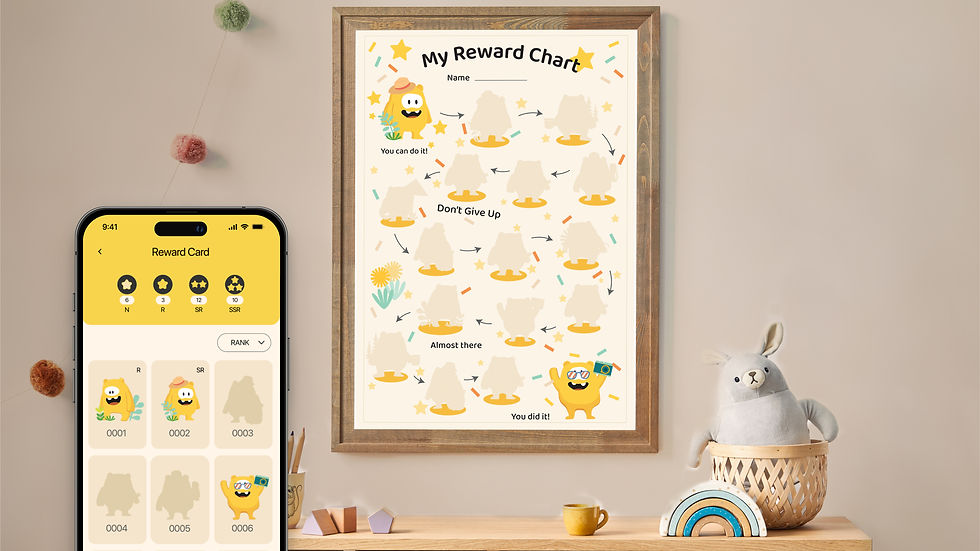
our solution can
1
Better assist children in achieving their task goals
2
Help ADHD families establish positive interactive relationships.
3
Help parents better understand their ADHD children
4
Build confidence and encourage sustained positive use of our product by both parents and children.
1
Better assist children in achieving their task goals
problem
Children with ADHD struggle to maintain attention, making their behavior difficult for parents to manage effectively.
feature 1
AI assistant that guides parents in creating step-by-step tasks for their children, helping to set specific time limits and assign corresponding rewards for each task.

feature 2
The AI assistant also enables parents to generate and organize task schedules through voice commands, allowing them to easily manage daily routines without manually entering each detail.

Real-Time Reminders and Task Tracking on the Watch
The child’s watch will provide reminders based on the tasks set by the parents in the app.
For example, when the child needs to pack their backpack or eat breakfast in the morning, the watch will remind them to carry out these activities, relieving the parents of the reminder burden.


2
Help ADHD families establish positive interactive relationships.
problem
Raising a child with ADHD brings significant stress to the entire family, potentially leading to poor parent-child relationships.
feature 3:
Real-Time Task Support and Encouragement
Parents can view their child's real-time task progress in the app.
If their child struggles to complete a task, they receive comforting reminders from the AI. Parents can then send encouraging messages to their child's watch through the app to keep them motivated.



3
Help parents better understand their ADHD children
problem
Parents lack understanding of ADHD symptoms and their own children
feature 4——learning
Learn more about the behavior and psychology of ADHD children.

feature 5:
Enhancing Parental Insight Through machine learning
As parents and children use the product, the wearable device collects data on the child’s daily activities and behavior.
Leveraging machine learning, the AI identifies patterns, refines its analysis over time, and provides parents with detailed summaries and insights to deepen their understanding of their child’s habits and behaviors.

4
Build confidence and encourage sustained positive use of our product by both parents and children.
problem
Children with ADHD often lack self-esteem and confidence in achieving goals, leading their parents to feel frustrated and believe their children are not as capable as others.
feature 6 :
Complete Tasks, Earn Rewards
When a task is completed, children can use the Gizmo printer to print reward cards and stickers for that task.
They can then exchange these reward cards with their parents for physical gifts based on the card's content.

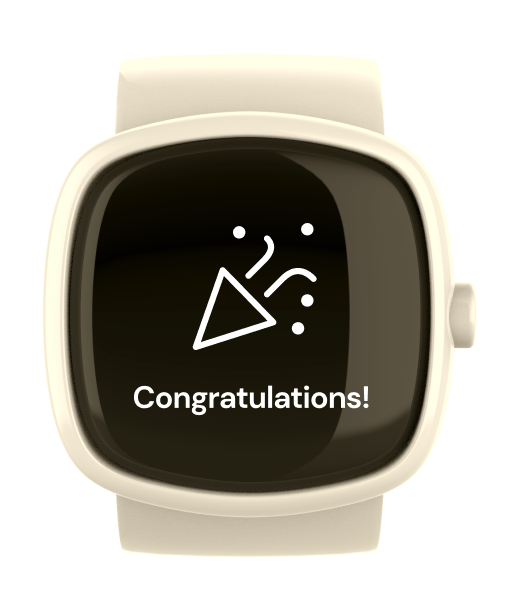


feature 7 —— reward poster board
We designed a reward poster board for parents and children to collect stickers at home, encouraging children to complete tasks with greater motivation and consistency while boosting parents' confidence in their progress.
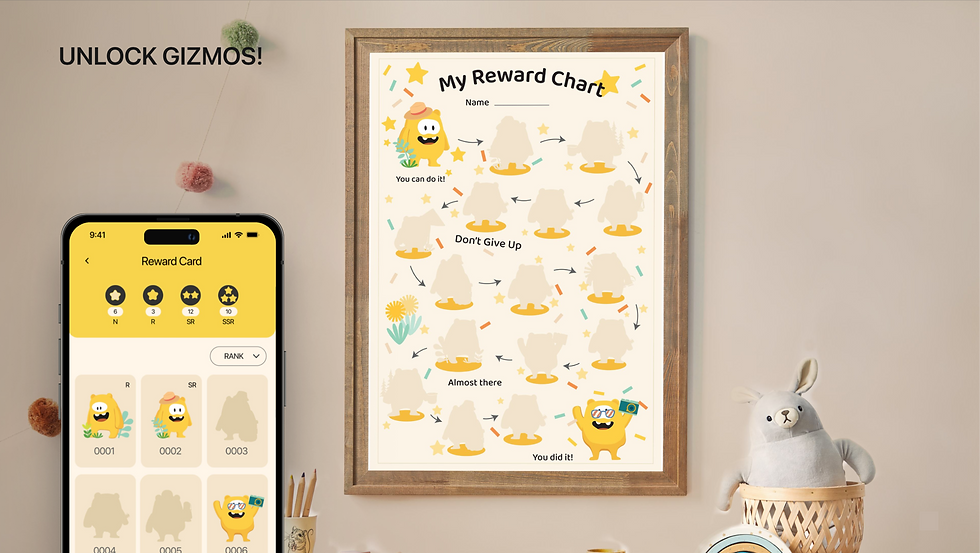
/Understanding / Support
/ Confidence


We conducted both secondary and primary research, organized key insights using an affinity map, and created an empathy map to better understand users' deeper pain points and needs.
research
Secondary Research
Through extensive literature review, social media research, and news analysis, we conducted a comprehensive investigation into various aspects of children with ADHD, including their daily lives, symptoms, treatment methods, as well as the challenges and pain points they face.
03
Children with ADHD tend to exhibit disruptive behaviors and are susceptible to feelings of low self-esteem, anger outbursts, and emotional instability.(Brown & Taylor, 2019)
04
Families of children with ADHD often face challenges, as parents frequently experience frustration and negative emotions. This can lead to ineffective parenting and an unstable home environment, hindering the child’s development and treatment progress (Johnson & Wilson, 2018).
01
The treatment of children with ADHD primarily depends on family support and behavioral interventions.
(Smith & Jones, 2020)
02
A structured daily routine, established and maintained with the help of parents, is crucial for children with ADHD, as it aids in better symptom management and adherence to treatment plans.(Green & Miller, 2021)
Primary Research

The next step involves conducting surveys, interviews, and online ethnography to gather current, personalized insights from parents and children with ADHD. These methods will help us understand specific challenges, behaviors, and unmet needs, ensuring our solutions are grounded in real-world experiences and user expectations.
survey
In-depth interview
Online Ethnography
Responds
(parents with ADHD child)
120+
15+
Responds(parents with ADHD child)
Members
(social media ADHD group)
87000+
Survey findings
Parents consider emotional control as a problem in parent-child relationship
100%
Parents face varying challenges in communicating with their children.
92%
Parents are dissatisfied with their children’s current daily task management
77%
Parents often feel negative emotions due to their children's ADHD symptoms.
62%
Parents think it’s challenging to initiate a task, keep focus, and understand steps
57%
Parents need more knowledge to understand children's behavior.
62%
Empathy Map
I create empathy maps for parents and children with ADHD to help us better understand and identify the unique challenges and needs they face.
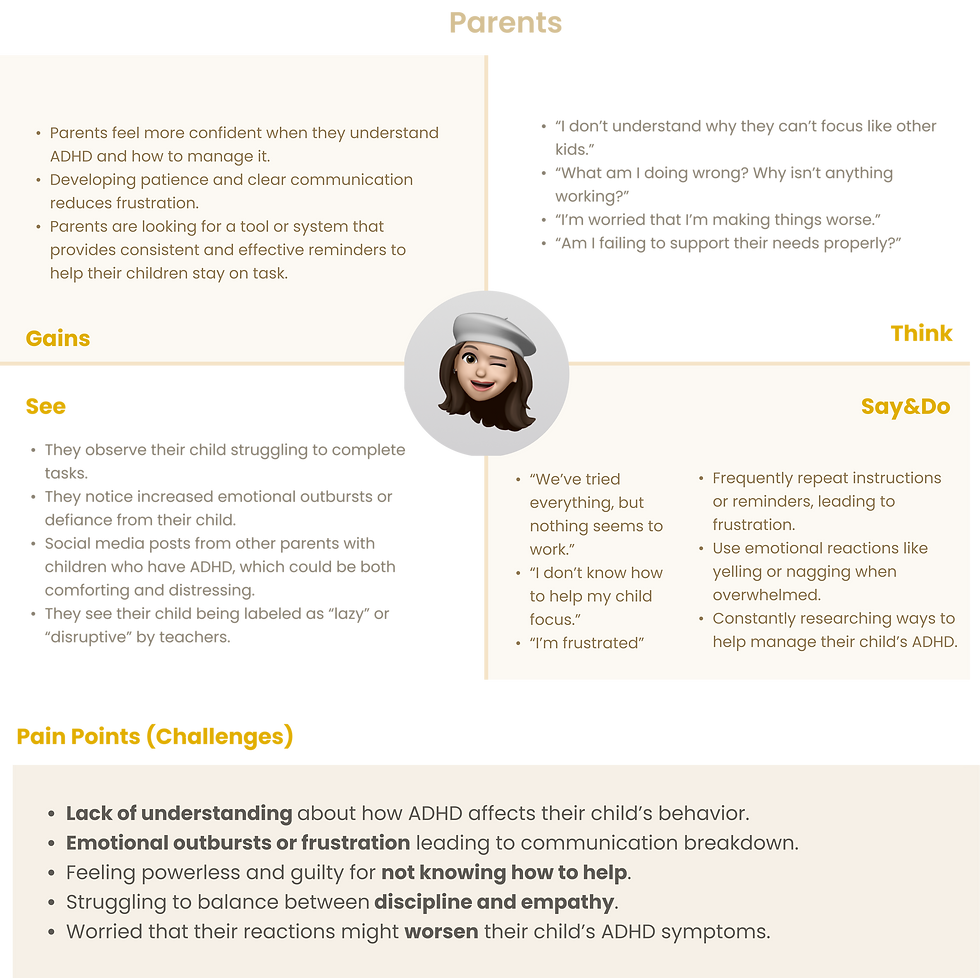
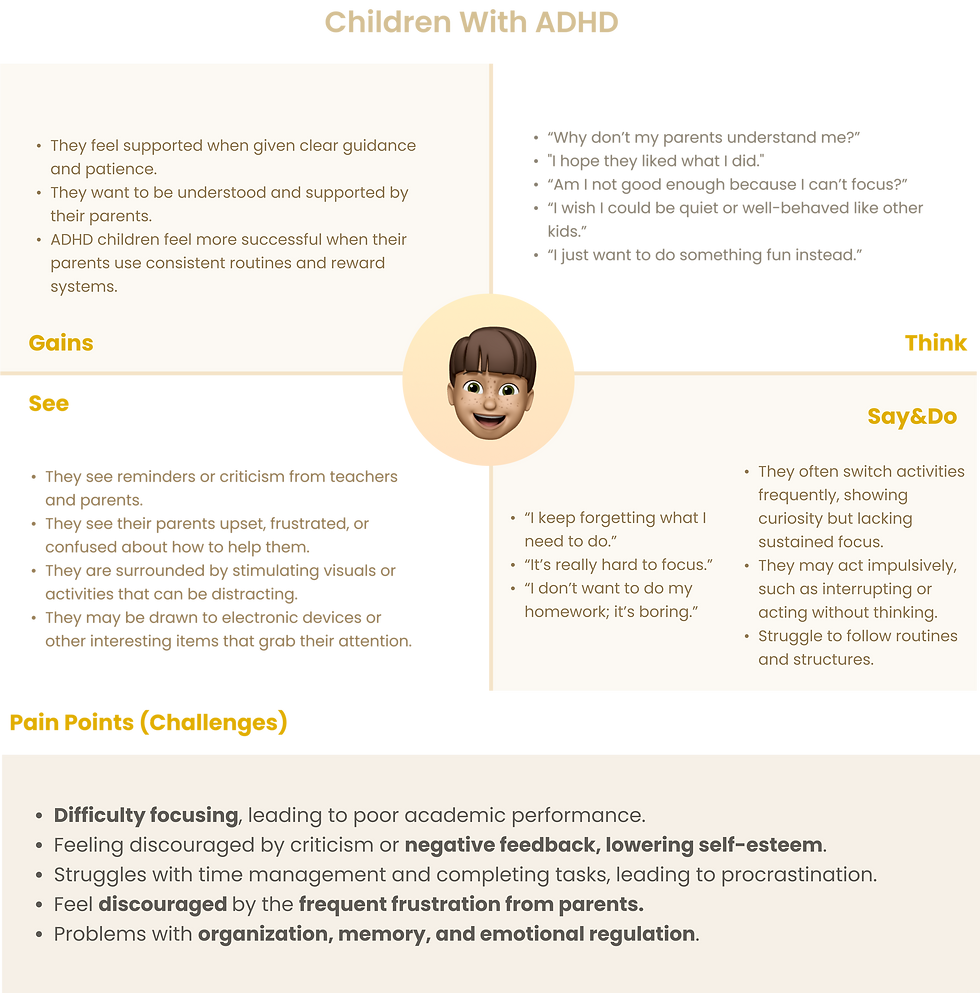
key insights
Using an affinity map, we organized data points and uncovered actionable insights to inform our design decisions.

Parents of children with ADHD face notable challenges in managing daily routines and academic responsibilities.
Parents often struggle with maintaining patience and managing their emotions.
A significant percentage of parents lack effective communication skills and techniques for interacting with children with ADHD.
Parents thrive on affirmation, inspiration, and meaningful encouragement.
Parents often feel uncertain in managing their children and benefit from gaining deeper knowledge and understanding.

Children with ADHD often struggle with concentration, experience low self-esteem, and frequently feel frustrated.
Regularly adjusted rewards help sustain motivation.
Each child has a unique threshold for sustained focus.
Breaking tasks into smaller steps helps maintain focus.
A significant percentage of parents lack effective communication skills and techniques for interacting with children with ADHD.
Electronic devices, like smartphones, can worsen ADHD symptoms.
Competitive Analysis
By conducting competitive analysis, we not only learn from the strengths of other products but also identify our own design advantages and areas for innovation.

How might we
1
2
3
How might we enhance family communication and understanding to empower parents in managing ADHD symptoms in children aged 6 to 12?
How might we create engaging tools that facilitate collaboration between parents and children, helping them set and achieve task goals together while strengthening their relationship?
How might we build confidence in children with ADHD by offering resources and features that celebrate their achievements, motivating both parents and children to continue using our product in a positive and sustained way?

ideation & concept testing
Based on all the research findings, I have refined actionable design principles and identified key opportunities, providing clear direction for the next phase of feature development.
We conducted brainstorming sessions during the ideation phase to address the pain points and needs of both parents and children. We tested our idea through interviews and surveys, gathering valuable feedback and suggestions. Based on this, we refined our design concept and adjusted our design goals accordingly.

prototype
We conduct an informal testing session among our peers first, we let them play the role of ADHD parents and examine issues in our mid-fi interfaces.
After the peer testing session, we generate the first iteration version of the App.


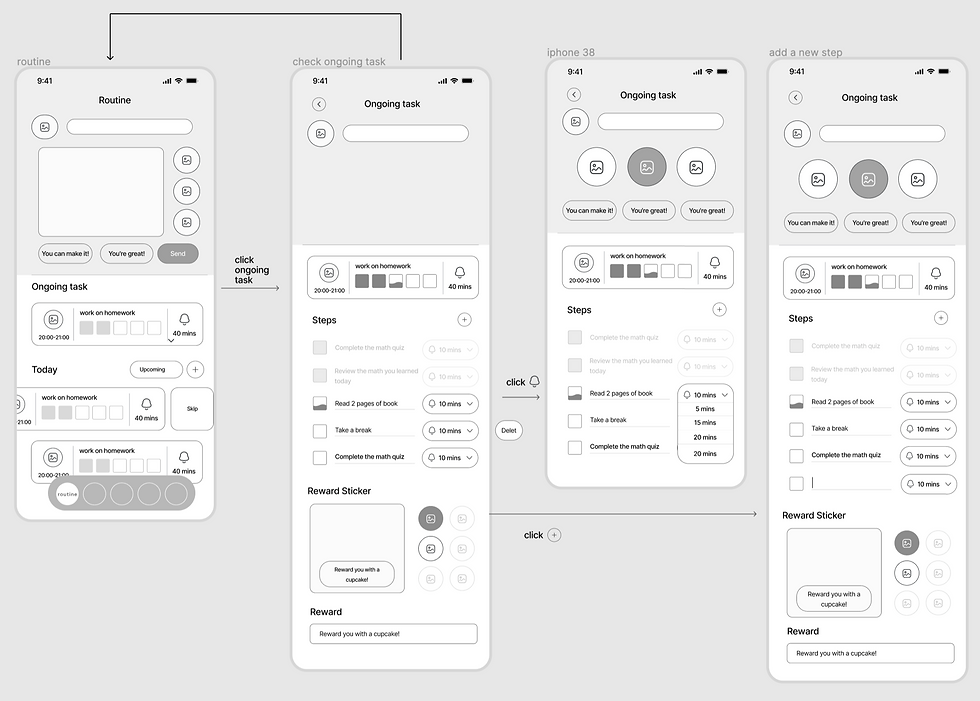


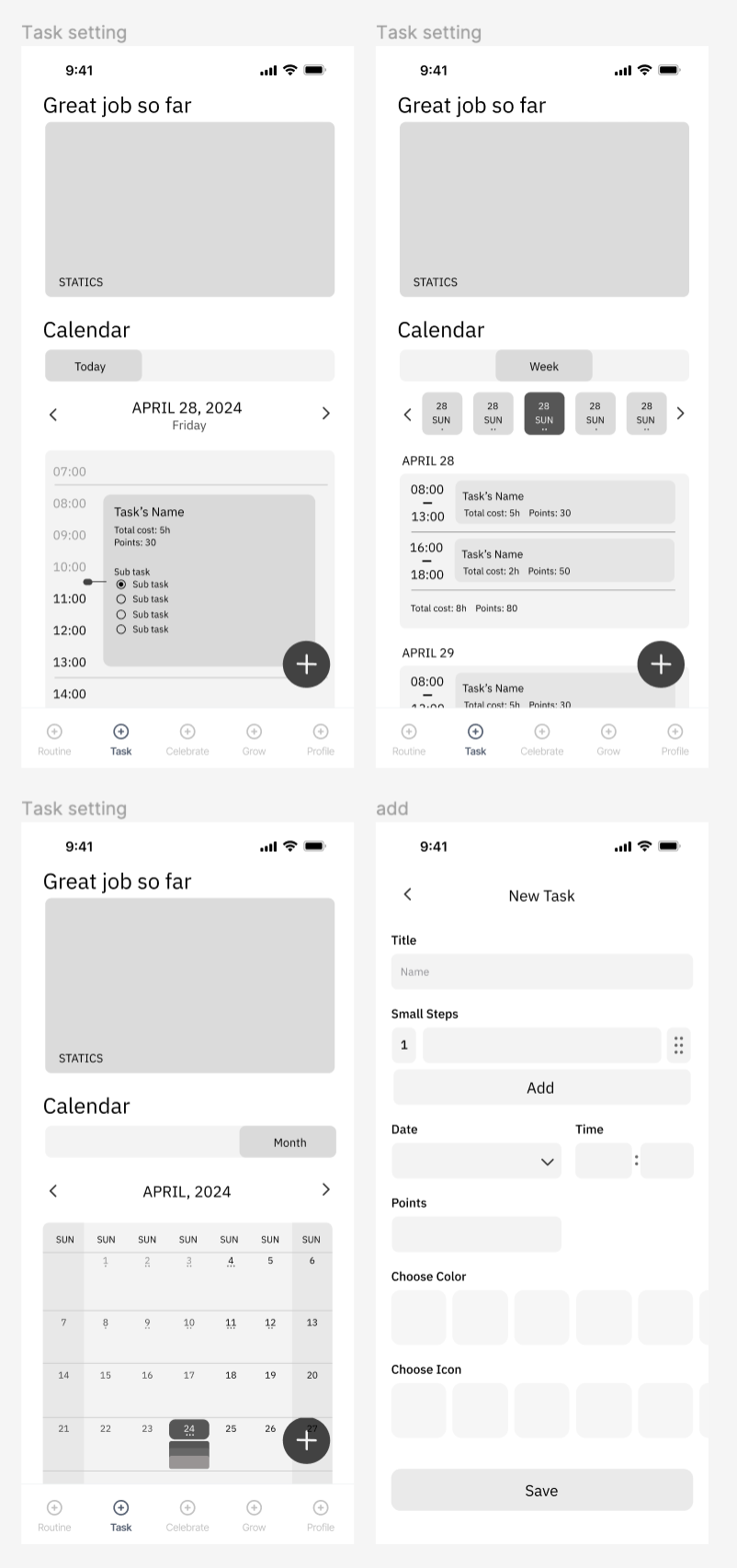


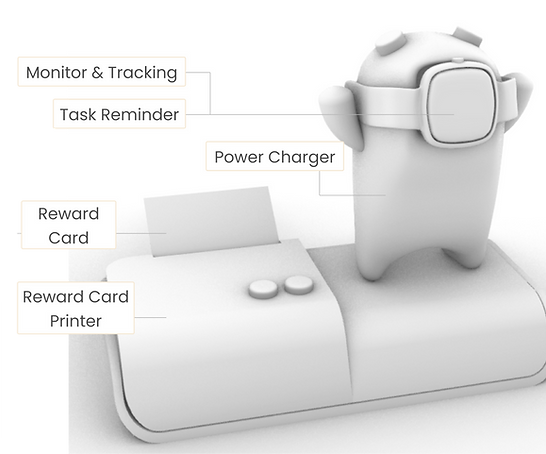
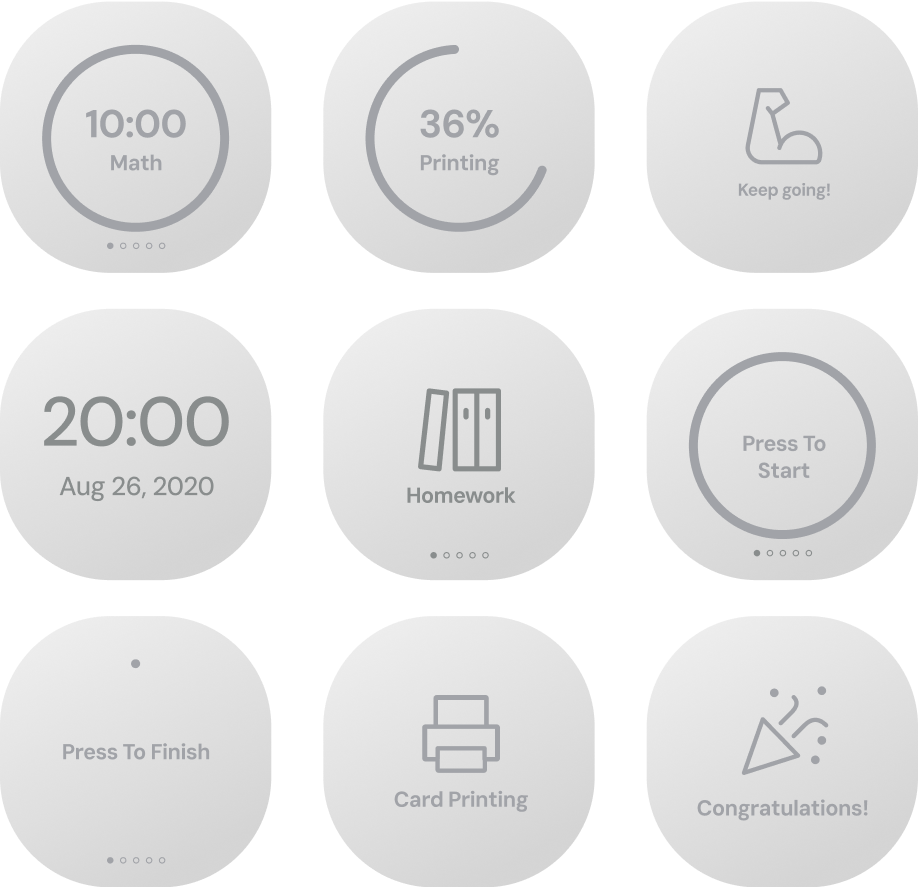
usability testing
We used a testing script alongside our Mid-Fidelity (Mid-Fi) prototype to evaluate user flows and gather comprehensive feedback on the design and functionality of our app.
Over the course of multiple iterations, we conducted 9 user tests (with 2 tests for each round of iteration) to collect both quantitative and qualitative data. Specifically, we analyzed several key factors to assess the effectiveness of the design:
Approach:
Task Completion Rate: Measuring how successfully users were able to complete assigned tasks.
Perceived Difficulty: Understanding the users' subjective perception of how challenging each task was.
Time to Complete Tasks:
Recording the amount of time users took to finish specific tasks, providing insight into efficiency.
Failed or Challenging Tasks: Identifying tasks that users found difficult or failed to complete with ease, highlighting areas that required improvement.

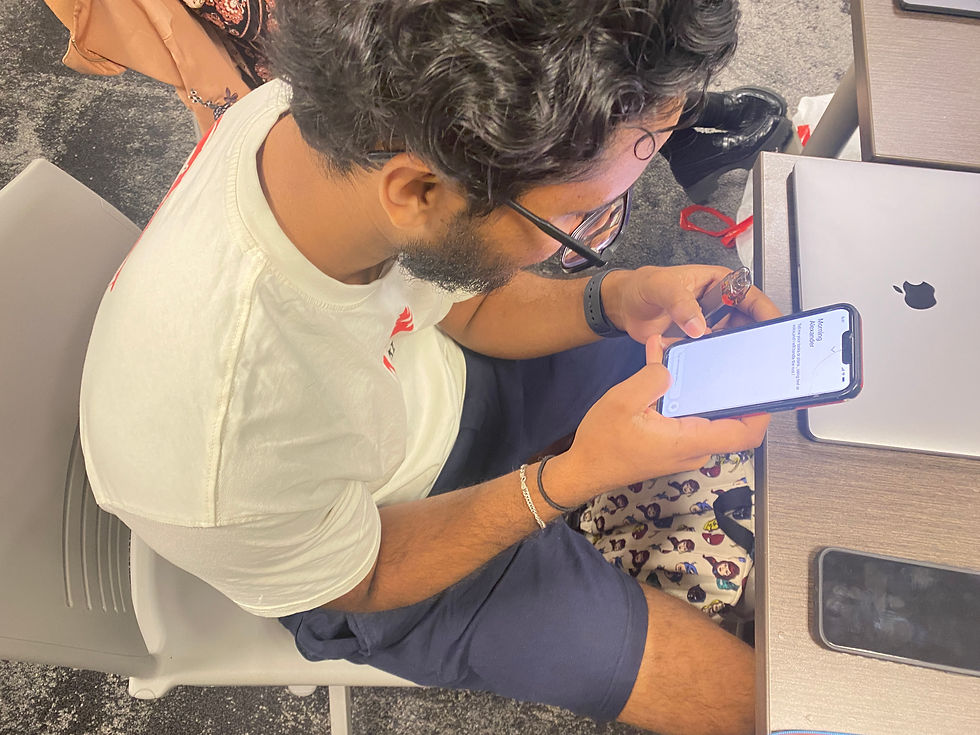

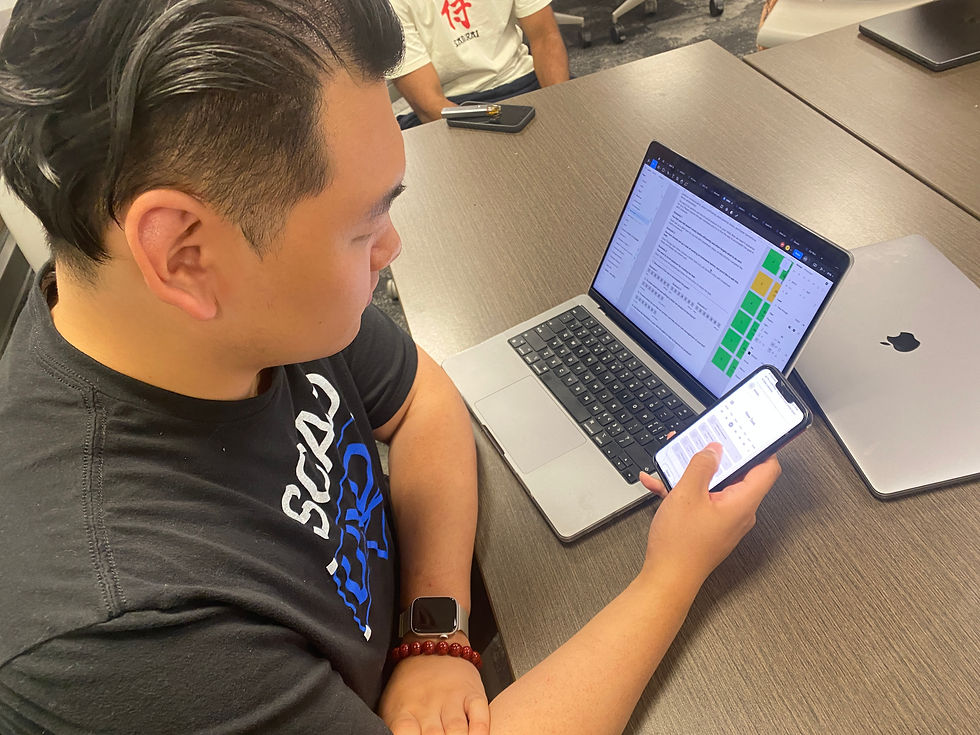
Task results
Improve
Error
Opportunity
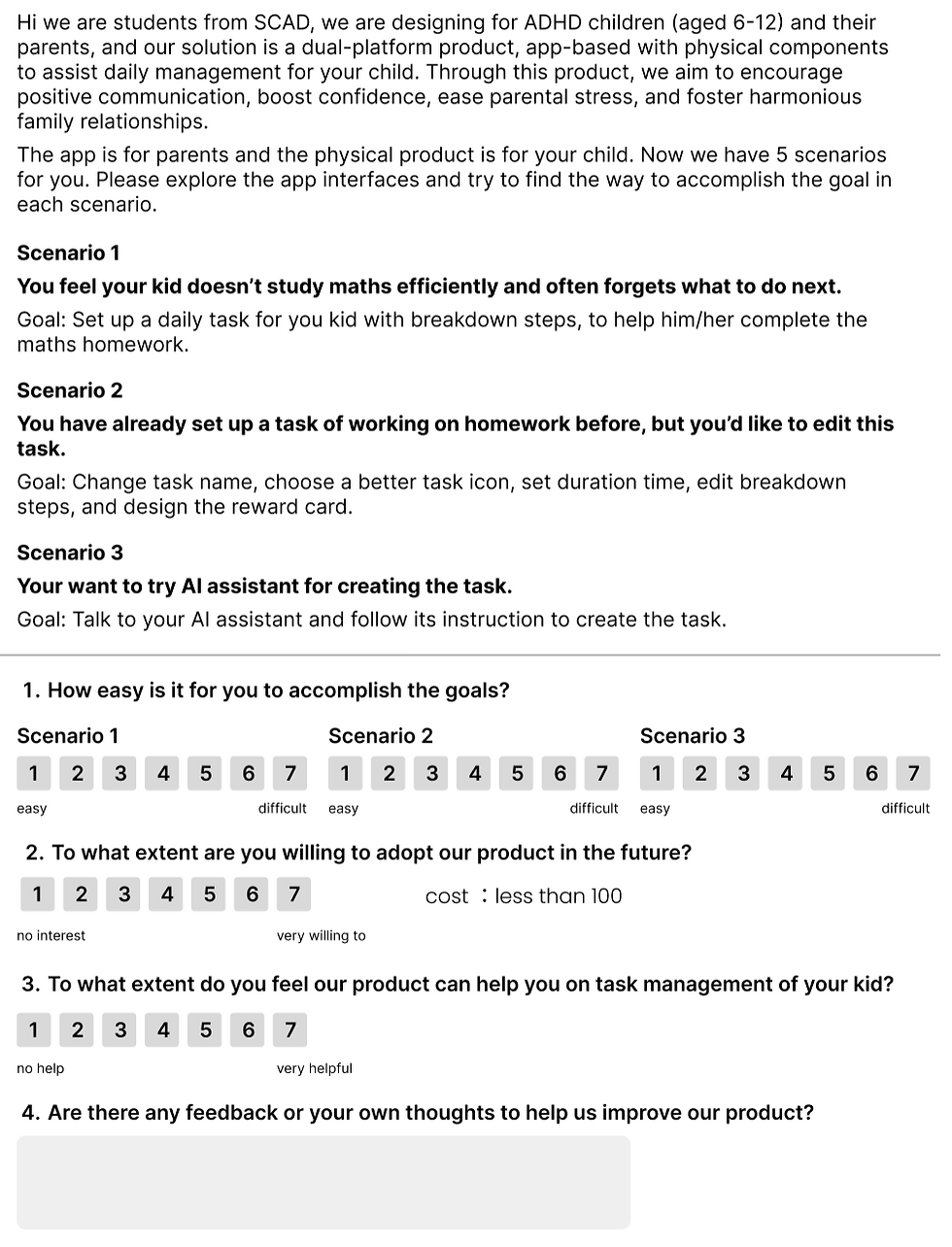

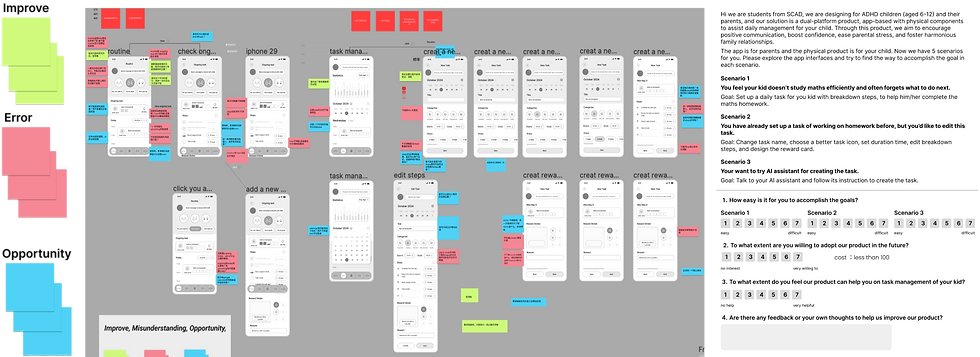
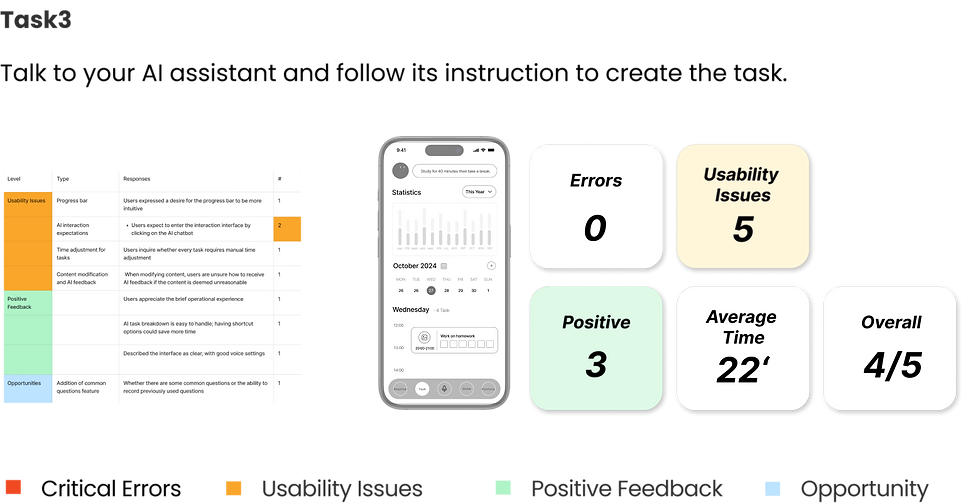
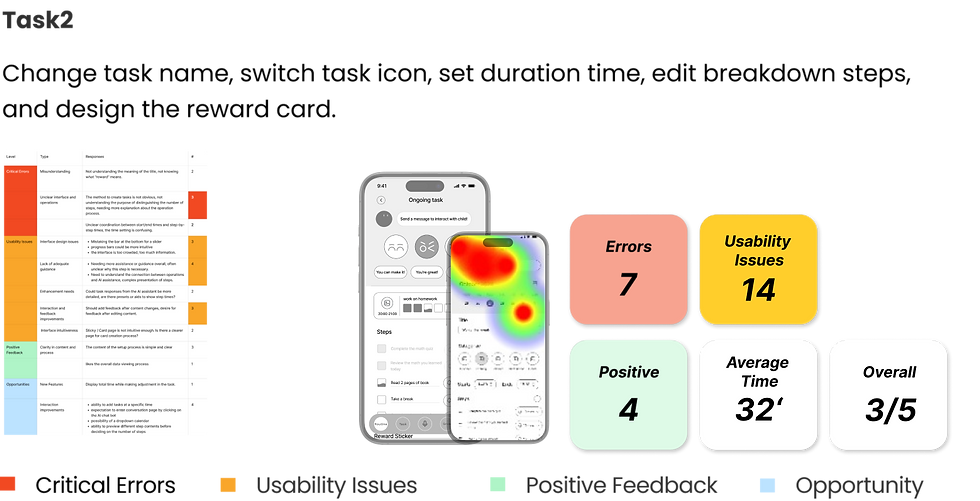


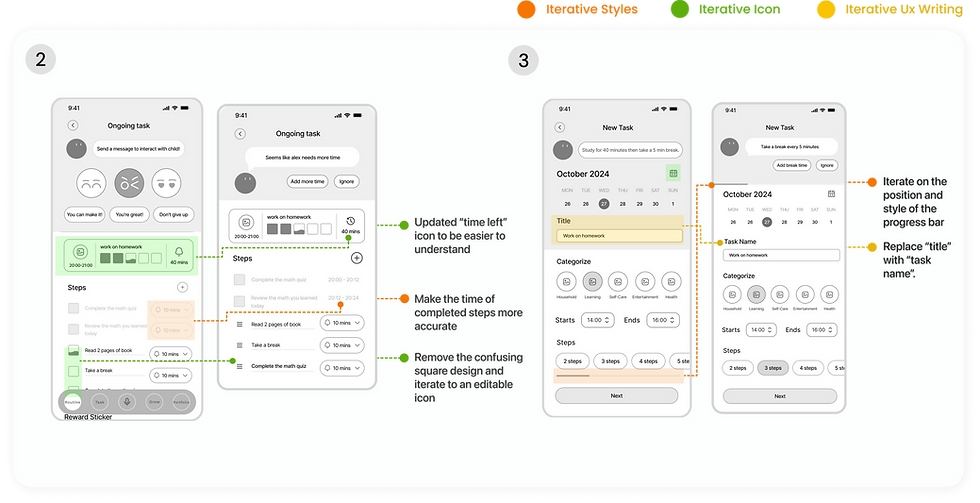

iteration
Based on user testing insights, I thoroughly refined the prototype to address key UX pain points.
My work focused on resolving issues such as confusing iconography, improving the clarity and precision of UX writing, and enhancing the visual hierarchy to create a more intuitive and user-friendly experience.






visual concepts
I collaborated with another team member to create five visual concepts, exploring styles that align with our product's tone, brand positioning, and the needs of parent-child products, and used testing and voting to finalize the visual style.


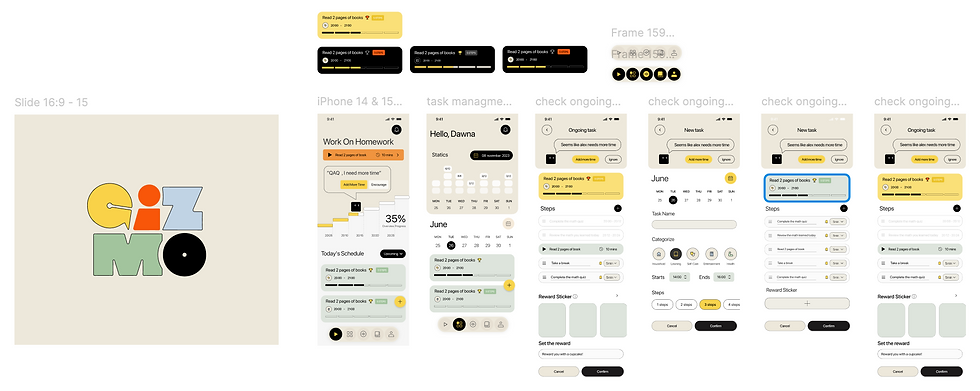

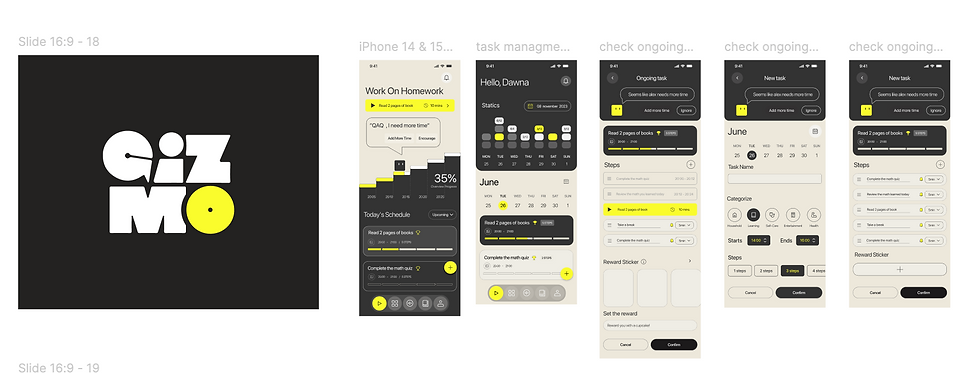
final design
We went through three rounds of iteration and explored various visual concepts, ultimately developing a UX-centered final design.
Feature Highlights
I collaborated with another team member to create five visual concepts, exploring styles that align with our product's tone, brand positioning, and the needs of parent-child products, and used testing and voting to finalize the visual style.
1
AI Task Assistant: Empowering Parents to Create Structured Activities for Their Children
2
Real-Time Support and Encouragement: Provides on-the-spot assistance and motivational feedback for effective task management.
3
AI-Driven Habit Analysis: Offers valuable insights into children’s habits, empowering parents with data to make informed decisions.
4
Interactive Reward System: Encourages task completion and fosters confidence in both parents and children through gamified rewards.
information architecture


HOMEPAGE
The homepage provides detailed information on the day's schedule and ongoing tasks, making it easier for parents to manage and monitor.

Innovative Design Feature:
Visually tracking task progress
A visual "step" diagram to show the progress of ongoing tasks, providing a more intuitive representation of task status.

Real-time synchronization with the watch
Syncs in real-time with the watch, interacts with children, and sends messages of encouragement and affirmation.

sCHEDULE
View the schedule details and task completion data.
With AI guidance, create more effective new task plans and set up corresponding rewards for the child.


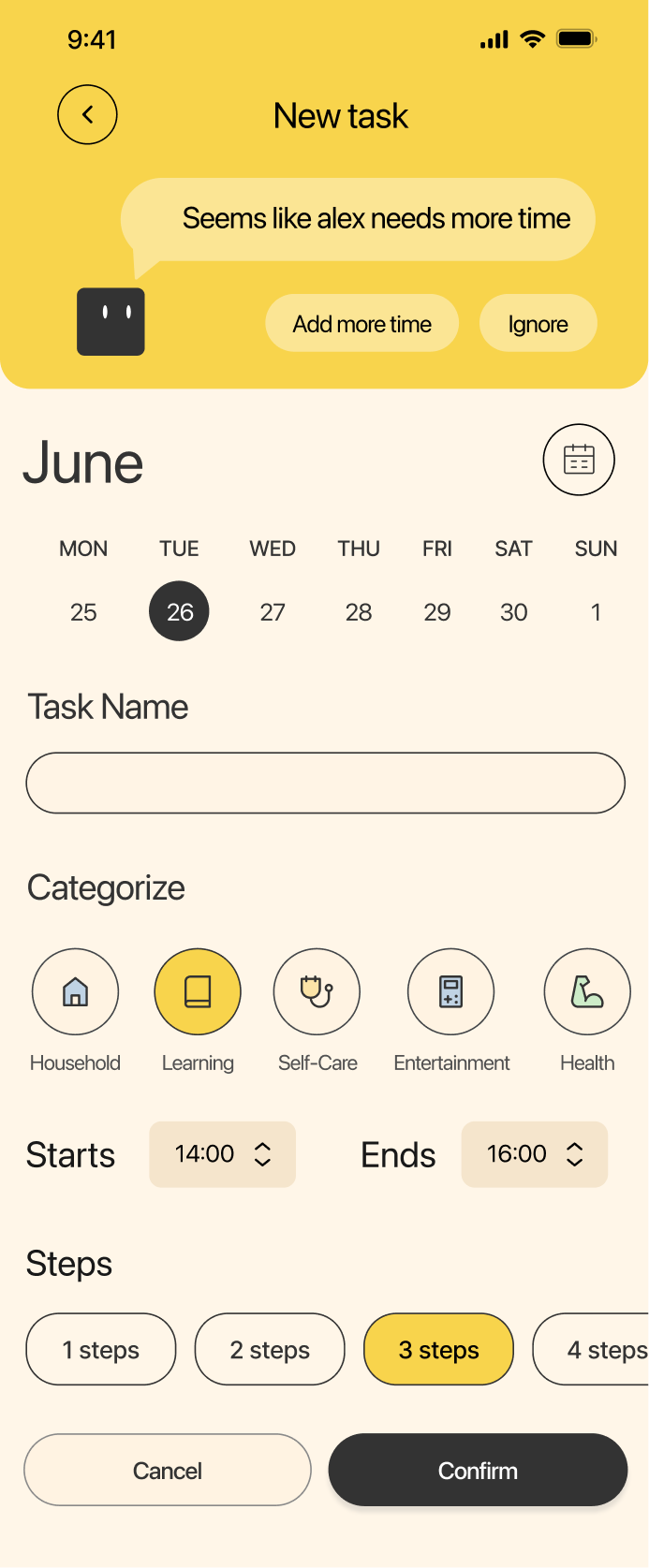
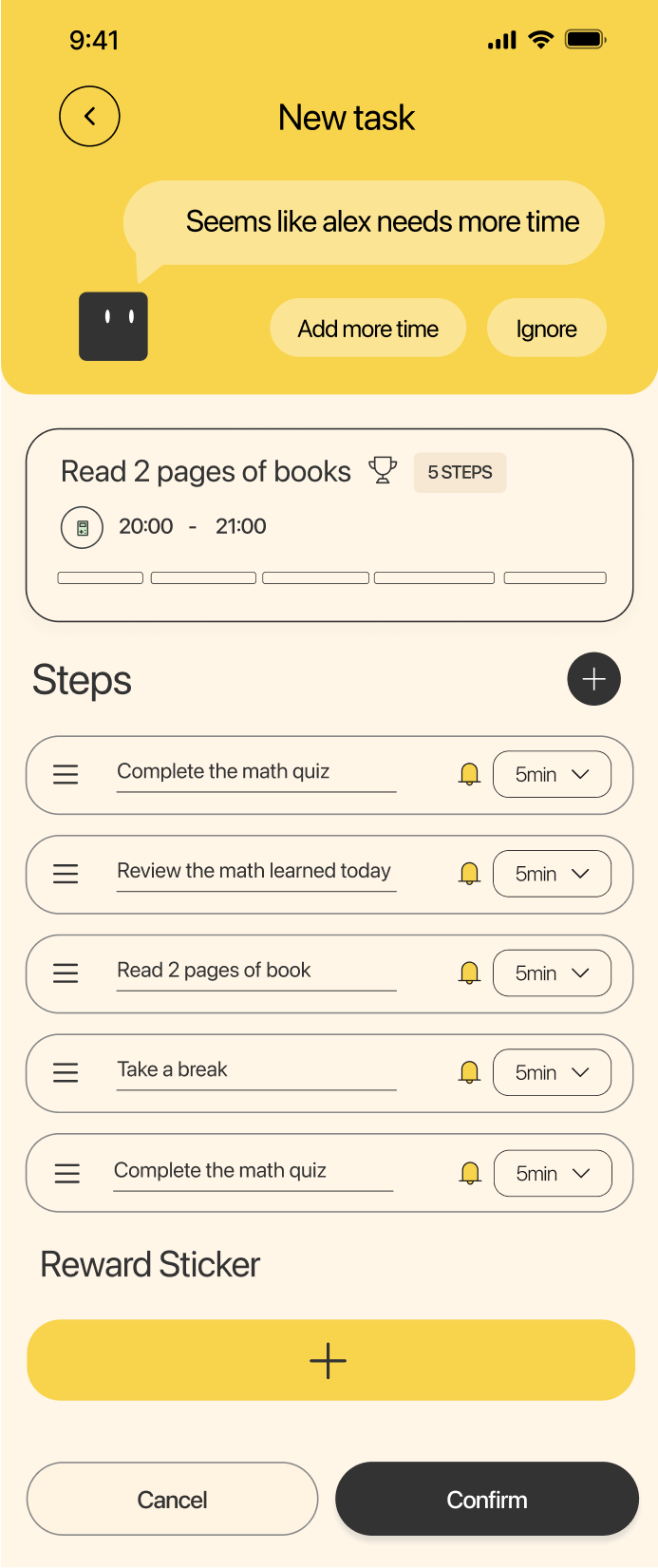
AI CHAT
Providing parents with support, relieving emotional stress, offering scientific guidance, and assisting in managing children with ADHD.

reward
Interactive Reward System: Motivating Task Completion and Building Parent-Child Confidence

learning & profile
Gizmo uses AI and machine learning to help parents manage their child's ADHD symptoms through personalized routines. It creates tailored schedules, tracks task completion and rewards, and analyzes behavior to provide insights.
This approach enhances symptom management and improves parent-child relationships.

Branding & Character Design


Character Design
Gizmo and MOMO provide love and support to help ADHD families overcome challenges and live happier lives, with MOMO as their constant source of joy.
reflection
How to Turn Research Findings into Meaningful Design Decisions
I learned how to integrate key research findings into design decisions, developing the ability to uncover users' deeper needs and pinpoint their true pain points. This experience strengthened my user research and analysis skills, allowing me to create designs rooted in genuine user insights.
How to Solve User Needs Through Strategic UI Design
I learned how to address user needs through UI design, using visual elements strategically to solve problems and enhance the product's usability. By focusing on creating clear, intuitive, and user-centered interfaces, I developed a deeper understanding of how thoughtful visual design can drive engagement and improve the overall user experience.



